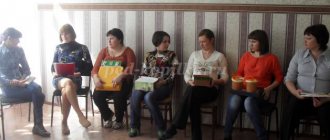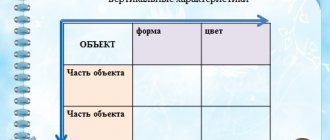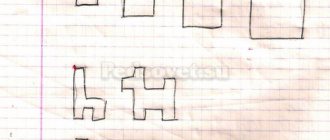Master class “Application of TRIZ methods in the everyday life of a kindergarten.”
Municipal preschool educational institution general developmental kindergarten No. 12 “Sun”
MASTER CLASS
Topic: “Application of TRIZ methods
in the daily life of the kindergarten."
1. Characteristics of the composition of teachers participating in the master class.
Dear members of the commission!
We present to your attention a TRIZ master class. The topic of the master class is “Application of TRIZ methods in the everyday life of a kindergarten.”
Before holding today's event, let me introduce you to the characteristics of the master class participants. This teaching staff consists of 14 people from different kindergartens in the city. Everyone has different work experience, different approaches to the upbringing and development of children.
2. Brief story about the upcoming event
.
The purpose of the master class: practical development of TRIZ technology.
Relevance: Education built on the assimilation of specific facts has become obsolete, because facts quickly become outdated, and their volume tends to infinity.
Novelty: the ideal of the 21st century education system is that the development of thinking will be the basis for the education of preschool children.
3. Rationale for the master class.
The rationale for this master class is a psychological and pedagogical orientation based on the principles of innovation and cooperation pedagogy. I consider myself a moderate innovator who improves on my previous experience.
4. The teacher’s answers to questions.
Dear members of the commission, before moving directly to the practical part and inviting participants, you may have questions for me. Well, now let me invite participants to conduct a master class.
Dear colleagues, I invite those who wish to come to the tables.
5. Conducting a master class.
Dear Colleagues! The topic of my master class is “Application of TRIZ methods in the everyday life of a kindergarten.
First, I would like to encourage you to think outside the box. Listen to the problem and help me solve it.
In ancient times, when a person could be sent to prison for financial debts, there lived a merchant who owed a large amount of money to a certain usurer. The latter - old and ugly - fell in love with the young daughter of a merchant and offered a deal: he would forgive the debt if the merchant gave his daughter for him.
The father was horrified by such a proposal. Then the insidious moneylender suggested casting lots: put two stones, black and white, in an empty bag, and let the girl pull out one of them. If she pulls out a black stone, she will become his wife, but if she pulls out a white stone, she will remain with her father. In both cases, the debt will be considered repaid. If the girl refuses to draw lots, then her father will be thrown into prison, and she herself will become a beggar.
The merchant and his daughter agreed to this proposal. At that time, when the moneylender bent down to pick up the stones for the lot, the merchant's daughter noticed that he had put two black stones in the bag. He then asked the girl to pull out one of them, thus sealing her fate and that of her father.
Now imagine that you have to draw lots. What would you do if you were in the shoes of this unfortunate girl? Or what would you advise her?
Each of you made your own assumption, but you came to this through careful logical analysis, which is stereotyped thinking. But there is another type of thinking - unconventional.
And here's your first task:
Within 2-3 minutes, trace your palm on a piece of paper and on each finger write the answer to the question “What do I expect from this master class?”
Life constantly presents us with challenges, and our fate depends on their solution. How to raise a person who can easily solve problems that arise? Teachers know well that any child can be a creative person; he is potentially talented from birth. And only improper upbringing and training destroys the germs of this talent in children..
To raise a talented person, it is necessary to develop in preschool childhood creative thinking, the ability to think outside the box, to look at the world around us.
Dear colleagues, I invite you to read out your answers to my question.
As a result of your answers, I assume that today at the end of the master class you will be able to:
- Explain what TRIZ pedagogy is
- See the possibilities of using TRIZ techniques in the everyday life of a kindergarten
First, let's define the concept of what TRIZ pedagogy is.
This is the youngest of the known and popular innovative pedagogical systems. It is based on TRIZ (the theory of inventive problem solving) and TRTL(), created by Russian scientist and science fiction writer Heinrich Altshuller. Its modern name is “applied dialectics”.
Purpose of TRIZ
— not just to develop children’s imagination, but to teach them to think systematically, with an understanding of the processes taking place.
Trizovites' motto
- “You can say everything!”
How to introduce TRIZ elements into the daily life of a kindergarten?
I carry out this work in stages:
STAGE 1 tasks
. To teach how to find and resolve contradictions in objects and phenomena that surround one, to develop systems thinking, i.e. the ability to see the environment in the interconnection of all components.
AT STAGE 2
. Teach children to invent objects with new properties and qualities: a new toy, an unusual dress, a gift, etc.
AT STAGE 3
. We solve fairytale problems and invent new fairy tales.
At STAGE 4.
I teach children to find a way out of any difficult situation. These tasks are solved in games and game exercises, which you will find in the instructions prepared for you. For a more complete understanding of TRIZ techniques, I suggest you play.
1 Game “Fantasy Polynomials”
Think of any 3 letter word. HOUSE
Under “D” we write words denoting the subject (nouns)
Under “O” - words denoting the properties or state of objects (an adjective or an adverb derived from it)
Under “M” are words denoting action and answering the question “what does it do?” Make a sentence out of words
for example, in a combination of 2, 3, 1. Then with your children you can come up with fantastic stories based on these combinations.
2 Game “Making a Limerick”
Limerick is the English version of organized absurdity. Within 5 minutes, try to come up with a limerick. It should be fabulous, mysterious, you can even use incomprehensible words, but so that the rhyme is preserved.
The first line is the choice of hero (red-blue teddy bear)
The second line is a description of the hero or his actions (flying across the sky)
The third line is the implementation of the action (how the hero did it) (flapping his paws like wings)
The fourth line is the choice of the final epithet or your attitude towards the hero (scared all the birds)
Do you understand the task? Please, let's get started.
In the process of completing the proposed tasks, children should not criticize their answers immediately, without explaining or developing their ideas. Most likely, the child could not convey it to us, express it correctly, or we did not understand it, since a child, unlike an adult, thinks directly, in an unearthly way. If we adults try to approach the issue from a real point of view, thinking through every step, then the child will not think about the laws of real life.
Well done on your creative approach to creating a limerick.
Reflection. Summing up the master class
And at the end of my master class, imagine that you spent today in a restaurant and now the restaurant director asks you to answer several questions: - I would eat more of this... - I liked it most... - I almost overcooked... - I overate... - Please add…
Who is ready to communicate with the restaurant director?
Well done, you did a great job with all the tasks. Use various TRIZ techniques, and the inexhaustible source of children's imagination will be fully revealed to you. I think that now you can answer the questions posed at the beginning of the master class. And so that you can better master TRIZ technology, I have prepared booklets for you. I am glad that you attended this event. Thank you for your attention.
6. Analysis of the event conducted by the teacher.
Dear members of the commission! You watched a master class on the topic “Application of TRIZ methods in the everyday life of a kindergarten.” In my analysis, I would like to focus on the fact that the tasks I set were achieved. I think that I managed to interest teachers in using TRIZ technology, since they actively participated and were emotional. Completing creative tasks contributed to the emancipation of teachers’ personalities and the activation of their creative abilities. To better see the possibilities of using TRIZ techniques in the everyday life of a kindergarten, I have prepared booklets and reminders. Along with the positive aspects, there were also shortcomings. Do you have any questions for me about this master class?
I was glad to see you at my master class, I will take into account all your recommendations and wishes. Thank you.
7. Questions and answers.
8. The teacher’s final generalization.
"TRIZ technology. Method "System analysis". Master class for preschool teachers
Municipal budgetary preschool educational institution
“Kindergarten No. 53 “Strawberry”
Master class for teachers
TRIZ technology
Method
"System analysis"
Purpose of the master class
: practical development of TRIZ technology.
Tasks:
1. Introduce colleagues to the theoretical foundations of technology;
2. Give an idea of the method “System (morphological) analysis”;
3. To introduce the practical application of the method in educational activities.
Form of conduct:
pedagogical living room.
Audience:
pedagogical community.
Relevance.
One of the important factors for a child’s success in school life is his ability to model, perform comparison, analysis, and synthesis operations.
From an early age, a child begins to think systematically, imagining the world in his imagination as an endless combination of various elements-signs and forms. Gradually, the child discovers that such elements can be controlled: combining them in different ways, replacing some elements with others, inventing objects that do not exist in reality. One of the interesting methods for developing imagination and thinking is morphological analysis.
Morphological analysis has a positive effect on the formation of a preschooler’s cognitive activity, i.e. on the need to acquire new knowledge, the ability to use it independently and rationally (find characteristic features in objects and phenomena of the surrounding world, classify objects according to certain characteristics, draw inferences).
I present to your attention a master class on using
the “System Analysis” method of TRIZ technology.
Method morphological analysis (MMA) is very effective for developing creative imagination, fantasy, and overcoming stereotypes. One of the interesting methods involving several mental operations (analysis, synthesis, generalization, comparison), the author of this method is F. Zwicky. The essence of the method is that mental operations are carried out using a table in which some indicators are set vertically and horizontally. The intersection of the values of these indicators is the basis of analytical activity. Its use allows the teacher to show in an accessible form the variability of signs of objects in the surrounding world even to the youngest children. This tool forms the mobility of thinking, the child’s ability to assimilate the principle of variability.
MMA is also very good for the formation of elementary mathematical concepts, familiarization with the environment, preparation for literacy, in project activities, visual and musical activities, etc.






